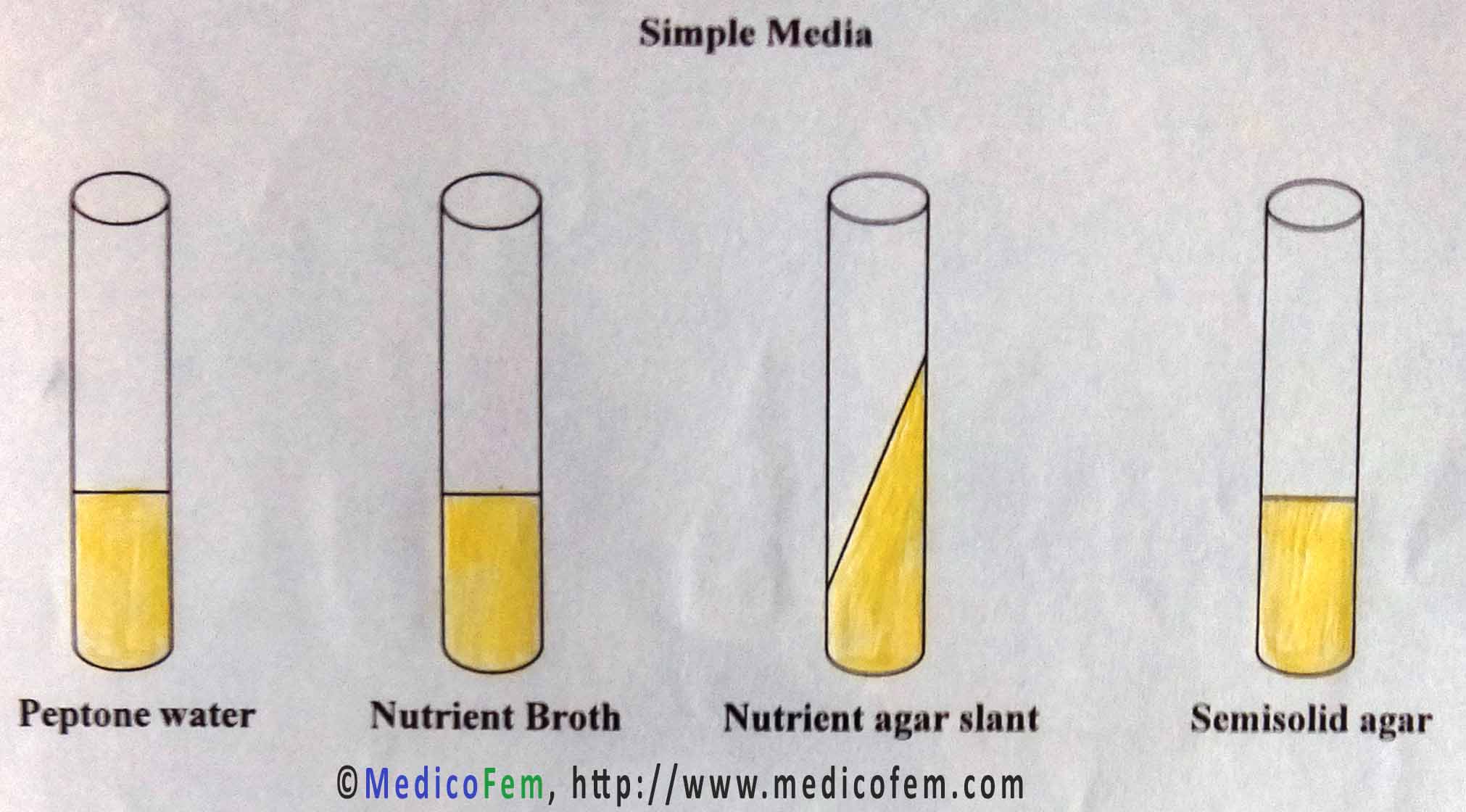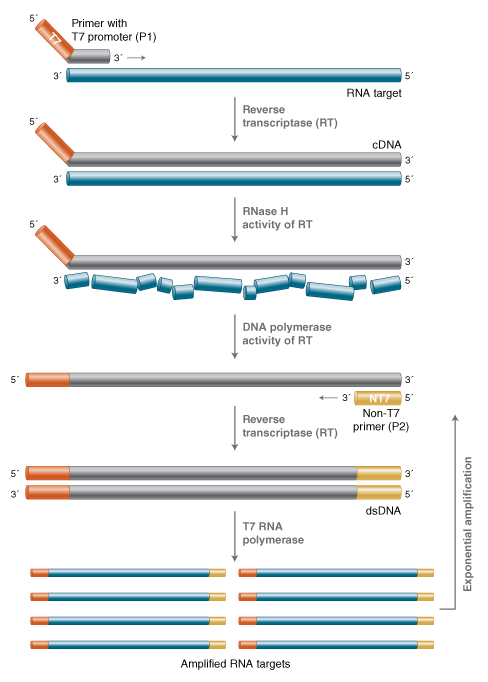- CULTURE MEDIA:
Culture media gives artificial environment simulating natural conditions necessary for growth of bacteria. The basic requirements for culture media are:
- Energy source.
- Carbon source.
- Nitrogen source.
- Salts
- Optimum pH.
- Adequate oxidation-reduction potential.
- Growth factors.
Components of culture media:
- Water– Source of hydrogen and oxygen.
- Electrolytes– NaCl & other electrolytes.
- Peptone– Mixture of partially digested proteins (animal or vegetable). Commercial peptone.
- Meat extract, yeast extract – Protein degradation products/carbohydrates/Inorganic salts/Growth factors.
- Blood– It enriches media. 5-10 % defibrinated horse or sheep blood (serum).
- Agar– Sea-weed (Algae-geledium species) Carbohydrates / Protein-like material / Fatty acids. 2-3 % concentration. It melts at 950 C and solidifies at 420 Agar acts merely as solidifying agent of culture medium and does not provide any nutrition to the bacteria.
Classification of media:
Media have been classified in many ways:
- Solid / Liquid / Semisolid
- Simple / Complex / Synthetic / Special
- Aerobic / Anaerobic
Simple media:
It is also called basal media. It consists of meat extract, peptone, sodium chloride and water.
Complex media:
There are ingredients for special purposes or for bringing out certain characteristics or providing special nutrients required for the growth of certain organisms.
Synthetic media:
These media are prepared solely from pure chemical substances and the exact composition of medium is known. They are used for research purposes.
Special media:
- Enriched media. growth enhancers like blood, serum or egg is added to basal medium to allow fastidious organisms to flourish.(Blood agar & chocolate agar)
- Enrichment broth. encourage the growth of small number of a particular organism while suppressing other flora present.(Alkaline peptone water)
- Selective media. support the growth of one type of microbe over another. It may contain inhibitory substances (antibiotics or other inhibitory chemicals) to prevent the growth of microbes. MacConkey agar for enteric Gram-negative bacilli.
- Indicator media. contain an indicator, which changes color when bacteria grow in them.(Sugar medium is an indicator medium)
- Differential media. allow grouping of microbes on the basis of different characters displayed on the medium. (Non-selective or selective)
- Transport media. special media required for transport of delicate microorganisms, like gonococci which may not survive the time taken for transportation or overgrown by non-pathogen. Stuart’s medium
- Anaerobic media. Used for anaerobic organisms. (Robertson’s cooked meat medium)
SIMPLE MEDIA

- Important Ingredient: Peptone, Salt, Water
- Basic requirement for growth of microorganisms
- Sterilization: Autoclaving
- Used as a base for other media
- Used for the growth of non- exacting microorganism
Nutrient Broth
- Peptone water & Meat extract
Nutrient Agar
- Nutrient broth & agar agar

Simple Medias
Semisolid Agar
- Used for detecting motility of bacteria
ENRICHED MEDIA
Blood Agar
- Important Ingredient: Nutrient agar & blood
- Blood is for enriching the medium
- Sterile blood added to Autoclaved nutrient agar at
- <55 0 C
- To differentiate the hemolytic properties
- Used for the growth of Staphylococci, Streptococci, Pneumococci & Neisseria group

Chocolate Agar
- Blood agar heated at 560 C for 1 hour
- When blood is heated factors X, Y and V are released from RBC, which are required for microorganisms
- Blood agar: 56 0 C / 30 minutes
- For growth of H. influenzae
- For growth of pyogenic Streptococci
- For growth of Neisseria group
Loeffler serum agar
- Important Ingredient: Nutrient broth, glucose, serum
- Serum and glucose for enriching the medium
- Sterilization: Inspissation
- For growth of C. diphtheriae
Dorset egg medium
- Important Ingredient: Nutrient broth, egg white & yellow
- Egg foe enriching the medium
- Sterilization: Inspissation
- Used for growth of Mycobacterium tuberculosis
ENRICHMENT MEDIA

Glucose Broth
- Important Ingredient: Nutrient broth & glucose
- Glucose is enriching for pyogenic organisms
- Sterilization: Tyndallisation
- Blood culture of pyogenic organisms
Selenite F broth
- Important Ingredient: Peptone water & sodium hydrogen Selenite
- Selenite enriches the growth of Salmonella and inhibits growth of coliform organisms
- Sterilization: Tyndallisation
- Enriching Salmonella species from faecal specimens
INDICATOR MEDIA

Sugar Media
- Important Ingredient: Peptone water, 1 % sugar, Andrade’s indicator
- Sugar fermentation gives acid and gas production
- Acid production is indicated by pink color
- Gas production is seen as a bubble formation in Durham’s tube
- Sterilization: Tyndallisation
- Used for the study of sugar fermentation
Hiss Serum Medium
- Important Ingredient: Sugar media, serum
- Used for the study of sugar fermentation for Pneumococci, C. diphtheriae, Neisseria
SELECTIVE MEDIA
Potassium tellurite Medium
- Important Ingredient: Nutrient agar, blood & potassium tellurite
- Blood is for enriching the medium
- Potassium tellurite is less inhibitory to C. diphtheriae compared to other throat commensals
- Sterilization: Autoclaving
- Used for the growth of C. diphtheriae
MacConkey’s Agar
- Important Ingredient: Peptone water, agar agar, sodium Taurocholate, lactose, neutral red.
- Sodium Taurocholate is inhibitory to non intestinal organisms
- Lactose will be fermented differently by different Enterobacteria
- Neutral red will give pink color along with lactose fermentation
- Sterilization: Autoclaving
- For growth of intestinal organisms
- For differentiating lactose fermenting organisms from non-lactose fermenting organisms
Alkaline peptone water
- Important Ingredient: Peptone water
- pH: 8.2
- High pH inhibits commensals other than Vibrio species
- Sterilization: Autoclaving
- Used for growth of Vibrio cholerae

MacConkey’s Medium, LJ Medium, RCMM
Lowenstein Jensen Medium
- Important Ingredient: Egg, Malachite green, mineral salts and glycerol
- Egg to enrich the medium
- Malachite green is least inhibitory for Mycobacterium tuberculosis
- Glycerol allows the growth of human variety
- Sterilization: Inspissation
- Used for the growth of M. tuberculosis, human variety
Cooked Meat Medium
- Important Ingredient: Nutrient broth & Meat pieces
- Meat pieces are for producing anaerobic condition
- Sterilization: Autoclaving
- For cultivation of anaerobic organisms
- For maintaining the stock culture
Sabouraud’s Medium
- Important Ingredient: Glucose, peptone, agar,
- pH: 5.4
- Low and high sugar content make it selective fore fungus
- Sterilization: Autoclaving
- For cultivation of fungi
Taurocholate Broth
- Important Ingredient: Nutrient broth & sodium Taurocholate
- Sodium Taurocholate is inhibitory to non-intestinal organisms
- Sterilization: Autoclaving
- For the growth of Salmonella from blood
TARNSPORT MEDIA
Stuart’s Media
- Important Ingredient: Charcoal, inorganic phosphates, buffer, sodium thioglycolate
- Charcoal absorbs the bacterial inhibitory substances
- Reducing agents prevents oxidation during the transportation
- Sterilization: Autoclaving
- Provides viability of Gonococci and aerobes

Stuart’s Medium, VR Medium, Glycerol Buffer Saline
V. R. Medium
- Important Ingredient: Crude salt
- pH 8.6
- High alkaline condition preserves viability of Vibrio species
- Sterilization: Autoclaving
- For transpiration of Vibrio Cholerae
Glycerol saline Medium
- Important Ingredient: Glycerol, sodium and potassium hydrogen phosphate
- Prevents growth of intestinal commensals
- Sterilization: Autoclaving
- Preserves Salmonella, Shigella from faecal specimens






